[Michael dives into the past with Vincent Feldman’s somber architectural photographs, and notes the relevance of Feldman’s work to Philly’s current housing issues. — the Artblog editors]
Cities in the United States have always had their hip neighborhoods to live in, be it in Greenwich Village in New York or the Mission in San Francisco. Philadelphia has its own rapidly developing neighborhoods to which city dwellers are flocking today, like Brewerytown, Fishtown, Northern Liberties, or West Philly. As gentrification happens, many families are displaced from their homes when rent is raised throughout these neighborhoods.
Artist Vincent Feldman has documented the resulting changes in the city’s appearance throughout the past 20 years. City Abandoned: Vincent Feldman captures Philadelphia’s now-destroyed neoclassical architecture in a series of photographs. The series is accompanied by an installation that illuminates Philadelphia’s segregated history, which was grounded in deep-seeded racial bias and ignorance.
Grim, grand ghosts
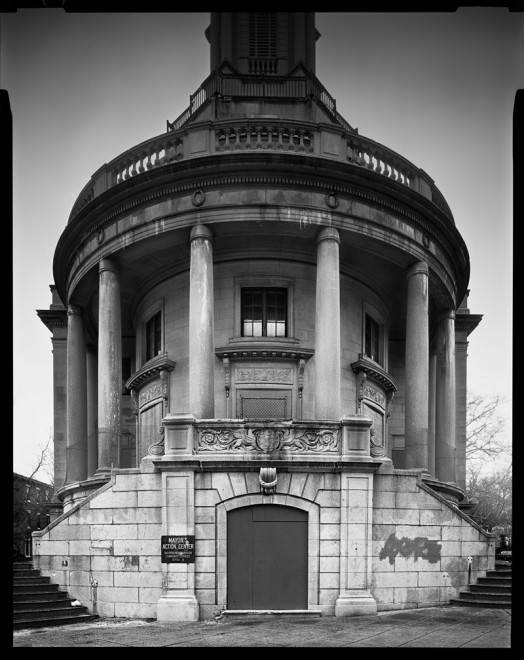
Feldman’s stark, black-and-white architectural photographs come from his book of photographs, City Abandoned: Charting the Loss of Civic Institutions in Philadelphia (2014, Paul Dry Books). The contrast-heavy photographs emphasize the thick layers of graffiti and sludge that have accumulated throughout each of these ailing architectural structures’ histories. Stripped of color, Feldman’s photographs capture the gloomy tone surrounding the final years of his subjects before many of them were destroyed entirely.
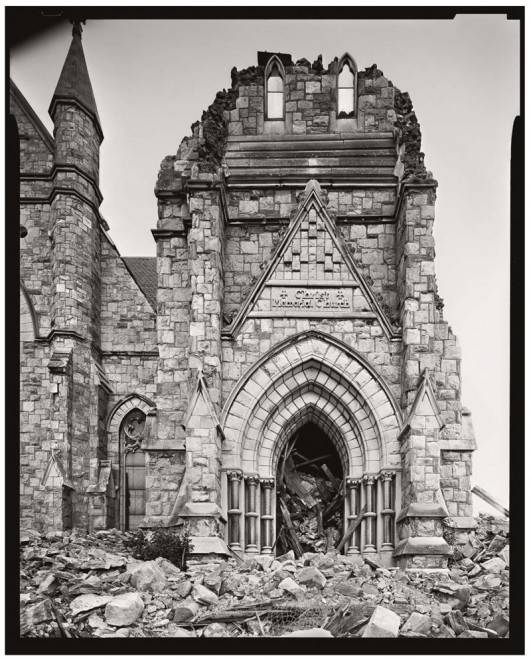
We are viewing many of these edifices postmortem, but some remain standing to varying extents. An image of the steeple-less Christ Memorial Church, on 43rd and Chestnut Streets, amid the ruin of its old steeple, displays a drastic foil to the contemporary structure’s now-manicured entrance, which bears no traces of the steeple’s destruction.
A sad game of “Where are they now?”
Feldman includes the locations of his photographs, effectively allowing viewers’ imaginations to run wild as they envision the buildings as they were when the artist began photographing the city in the early 1990s, and what traces of them remain today. This connection between a photograph and a tangible location in Philadelphia evokes an emotional attachment to each of the institutions on display, which, in many instances, have since been destroyed.
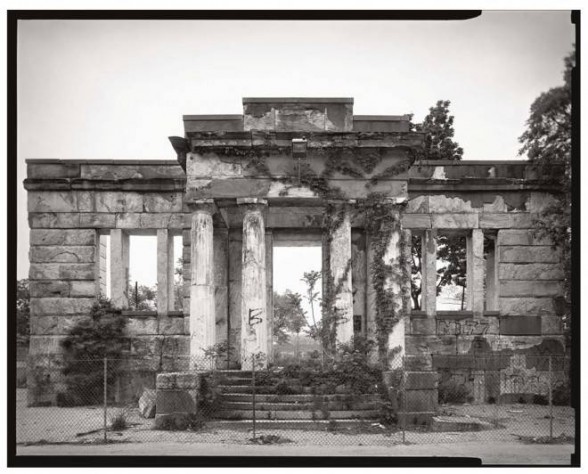
One image that piqued my interest was that of the Pennsylvania Hospital for the Insane, on 44th and Market Streets, which was demolished in 1959 and developed by the Philadelphia Housing Authority into the Westpark Apartments, which still remain today. The eerie fragment Feldman captures is a sliver of the hospital’s history before the city exercised eminent domain.
For many of us who have not witnessed the city’s transformation into its current state, this exhibition is a transfixing narrative that sheds light on how quickly Philadelphia has changed. Sadly, photographs of some of these beautiful architectural edifices are from the city’s recent past.
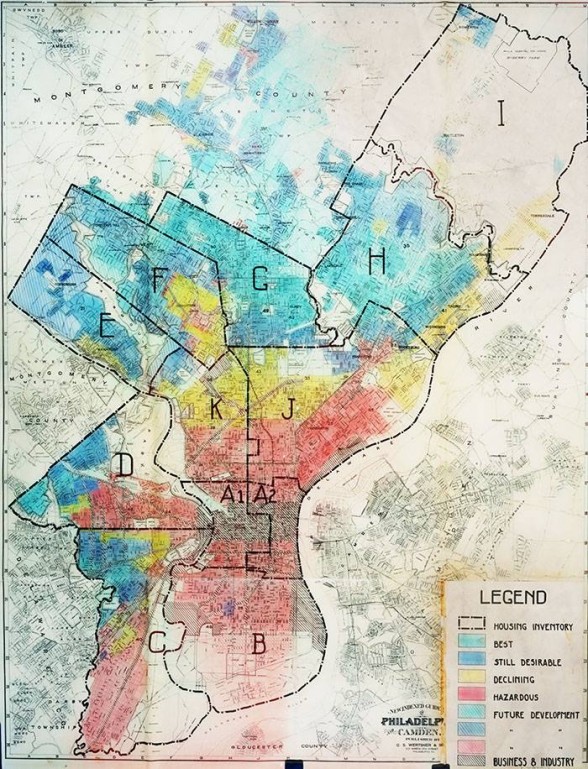
The installation accompanying Feldman’s photography examines the political roots of Philadelphia’s city planning, and includes a series of maps examining the research of the Home Owners Loan Corporation, or the HOLC, into the desirability of locations throughout the city. These studies informed where the HOLC would offer long-term refinancing for homeowners in attempts to combat the effects of the Great Depression.
What is quickly exposed is the racial bias that allowed for a white flight from inner-city Philadelphia, started by racist federal housing legislation by the HOLC that was continued with the Philadelphia Transit Strike of 1944 and Columbia Avenue Riots in the 1960s.
Past informs future
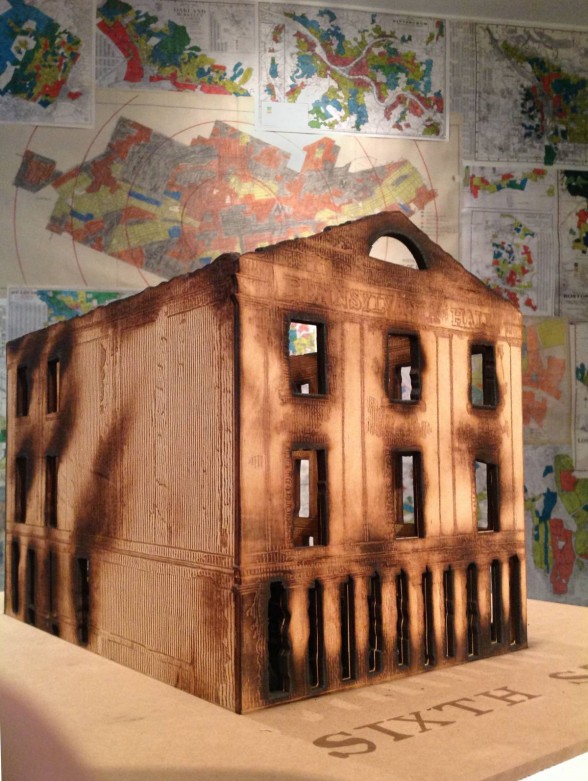
The dark history charted in these maps is the backdrop for a sculpture of the charred ruins of Pennsylvania Hall. This building opened May 14, 1838, as the first meeting space for abolitionists in the United States–only to be burned down four days later. The mob responsible for the destruction is said to have included 10,000 men and women who ransacked the building in front of city officials who allowed the injustices that occurred.
The artist’s sculptural vision acts as a supplement to the hidden layers housed in each of his photographs.
City Abandoned comes to University of the Arts at a critical time in the city’s continuing development. The resulting gentrification has begun to displace present residents of these now in-vogue neighborhoods. And to keep up with demand, buildings are bulldozed and replaced with new, plastic-y, modern structures that are thrown together in a matter of months.
Feldman’s black-and-white photographs are ever pertinent to Philadelphia’s growing skyline; they draw attention to the history that is lost with every building that is destroyed. City Abandoned informs viewers of this otherwise hidden history with a series of complex, emotional photographs that could more appropriately be called portraits of these lost monuments. Because of Feldman’s photographic pursuits, the histories of the demolished structures can slowly be rebuilt.
City Abandoned: Vincent Feldman is on display at Harrison & Arronson Galleries, Hamilton Hall, University of the Arts, from Jan. 17 – Feb. 7, 2015. For more information about Vincent Feldman’s work, visit his website, and be sure to read this interview with the artist from Hidden City Philadelphia.









